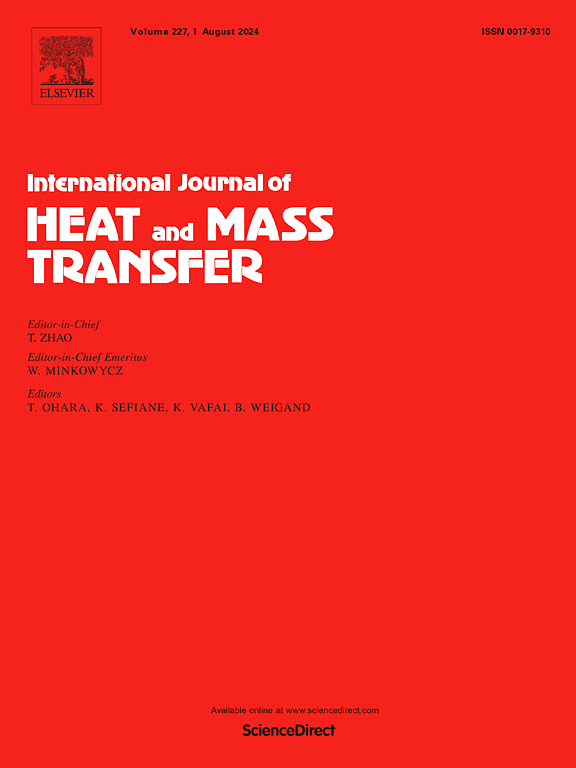用于低品位绿色能源开发的新型同轴冷凝热管 (CCHP) 的热流体力学性能和喷泉沸腾流
IF 5
2区 工程技术
Q1 ENGINEERING, MECHANICAL
International Journal of Heat and Mass Transfer
Pub Date : 2024-11-12
DOI:10.1016/j.ijheatmasstransfer.2024.126391
引用次数: 0
摘要
由于具有出色的传热效率,两相封闭热虹吸管(TPCT)对于太阳能应用和电子设备冷却至关重要。本研究提出了一种新型同轴冷凝热管(CCHP),与传统热管相比,在相同体积和传热面积的情况下,其结构更为紧凑。研究充分利用数值建模和实验研究,考察了热输入、倾斜角、液体填充率和工作介质对 CCHP 传热性能的影响。研究还探讨了 CCHP 在不同工作条件下的汽液流动现象以及热传导和质量传输机制。研究结果表明,当填充率为 50%、输入功率为 100 W 时,CCHP 在倾斜角度为 60° 时具有最佳的热传导性能,其最小热阻为 0.284K/W。在倾斜角度为 60°、输入功率为 100 W 时,CCHP 的热阻最小,为 0.267K/W。此外,使用乙醇作为工作介质可同时降低蒸发器温度和提高 CCHP 的热性能。在 CCHP 内部还进一步观察到了 "喷泉沸腾 "现象。我们的实验结果与数值结果相互吻合。这种创新的热管可以在太阳能收集和相关传热增强领域得到可靠和稳健的应用。本文章由计算机程序翻译,如有差异,请以英文原文为准。
Thermo-hydrodynamic performance and geyser boiling flows of a novel co-axial condensing heat pipe (CCHP) for low-grade green energy exploitations
Due to their excellent heat transfer efficiency, two-phase closed thermosiphons (TPCTs) are essential for solar applications and the cooling of electronics. In this research, a novel coaxial condensing heat pipe (CCHP) was proposed, which has a more compact structure compared to traditional heat pipe, given the same volume and heat transfer area. Numerical modeling and experimental investigation were fully utilized to examine the influences of heat inputs, inclination angles, liquid filling ratios, and working mediums on the heat transmission properties of CCHP. The vapor-liquid flow phenomenon along with the thermal and mass transmission mechanism of CCHP under various operating conditions were explored. Our findings demonstrated that CCHP exhibited optimal thermal transmission performance at the tilt angle of 60° when the filling rate is 50 % and the input power is 100 W, the minimum thermal resistance of CCHP is 0.284K/W. At the tilt angle of 60° and input power of 100 W, CCHP has the lowest thermal resistance of 0.267K/W. Besides, the utilization of ethanol as a working medium could simultaneously reduce the evaporator temperature and enhance the thermal properties of CCHP. Inside CCHP, "geyser boiling" phenomena was further observed. Our experimental findings and numerical ones agreed well for each other. This innovative heat pipe could be confident and robust applied in the solar energy collection and relevant heat transfer enhancement fields.
求助全文
通过发布文献求助,成功后即可免费获取论文全文。
去求助
来源期刊
CiteScore
10.30
自引率
13.50%
发文量
1319
审稿时长
41 days
期刊介绍:
International Journal of Heat and Mass Transfer is the vehicle for the exchange of basic ideas in heat and mass transfer between research workers and engineers throughout the world. It focuses on both analytical and experimental research, with an emphasis on contributions which increase the basic understanding of transfer processes and their application to engineering problems.
Topics include:
-New methods of measuring and/or correlating transport-property data
-Energy engineering
-Environmental applications of heat and/or mass transfer

 求助内容:
求助内容: 应助结果提醒方式:
应助结果提醒方式:


